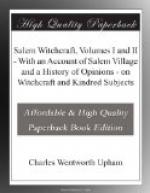It can hardly be doubted, that Singletary’s story was the result of the workings of an excited imagination, in wild and frightful dreams under the spasms of nightmare. We shall meet similar phenomena, when we come to the testimony in the trials of 1692.
Godfrey was a most eccentric character. He courted and challenged the imputation of witchcraft, and took delight in playing upon the credulity of his neighbors, enjoying the exhibition of their amazement, horror, and consternation. He was a person of much notoriety, had more lawsuits, it is probable, than any other man in the colony, and in one instance came under the criminal jurisdiction for familiarity with other than immaterial spirits; for we find, by the record of Sept. 25, 1666, that John Godfrey was “fined for being drunk.”
I have allowed so much space to the foregoing documents, because they show the fancies which, fermenting in the public mind, and inflamed by the prevalent literature, theology, and philosophy, came to a head thirty years afterwards; and because they prove that in 1660 a conviction for witchcraft could not be obtained in this county. The evidence against none of the convicts in 1692, throwing out of view the statements and actings of the “afflicted children,” was half so strong as that against Godfrey. Short work would have been made with him then.
There is one particularly interesting item in Singletary’s deposition. It illustrates the value of good preaching. This young man, in his gloomy prison, and overwhelmed with the terrors of superstition, found consolation, courage, and strength in what he remembered of a sermon, to which he had happened to listen, from “Matchless Mitchel.” It was indeed good doctrine; and it is to be lamented that it was not carried out to its logical conclusions, and constantly enforced by the divines of that and subsequent times.
In November, 1669, there was a prosecution of “Goody Burt,” a widow, concerning whom the most marvellous stories were told. The principal witness against her was Philip Reed, a physician, who on oath declared his belief that “no natural cause” could produce such effects as were wrought by Goody Burt upon persons whom she afflicted. Her range of operations seems to have been confined to Marblehead, Lynn, Salem, and the vicinity: as nothing more was ever heard of the case, another evidence is afforded, that an Essex jury, notwithstanding this positive opinion of a doctor, was not ready to convict on the charge of witchcraft. This same Philip Reed tried very hard to prosecute proceedings, eleven years afterwards, against Margaret Gifford as a witch. But she failed to appear, and no effort is recorded as having been made to apprehend her.




